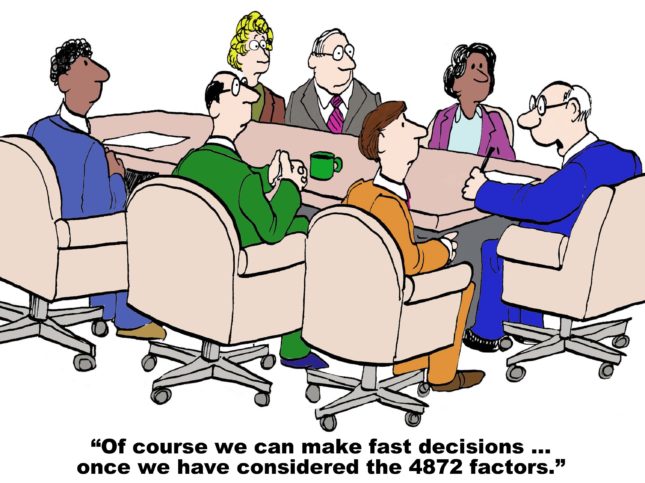Just Ask
Podcast: Play in new window | Download
Seasoned negotiators know, and researchers have proven, that those who ask for more, get more.
But it’s not limited to negotiation scenarios—it works in any important communication opportunity when you are trying to get compliance from someone, such as asking for help or getting approval from your senior leadership on an important project. You stand a much better chance of accomplishing your aim if you tell others what you want clearly, directly and early in the conversation.
It boosts the chances of getting what you want
Knowing what you want increases the chances you will get it. If you’re explaining a situation to someone, it may be the first time they’ve thought about it, so they simply can’t put the same time into thinking about it that you have. There is a good chance that they will be at least slightly uncertain about what to do—your recommended decision acts as an anchor for their final decision, and anchors can set the terms of the discussion.
It conveys confidence and credibility
Being clear about what you want also makes you look more credible and puts you on a more equal footing with the other person. It makes you an active participant in the value creation process, not simply someone supplying inputs for a decision. Decision makers generally don’t like people who bring problems to them without at least suggesting a solution. They don’t have to agree with the proposed solution, but they will appreciate the fact that you’ve thought about it.
It clarifies your own thinking
In fact, the process of figuring out what to recommend will force you to think deeply and clearly about the situation, including root causes, costs and alternatives, so it should improve the quality of the end product, which is the best ultimate driver of your personal credibility.
It also helps the other party
Think about your “customer” for a minute: the person whom you’re asking to make a decision based on the information you provide. A top executive is essentially an engine for making decisions, and they have to make a lot of them. That does not mean it gets easier for them. They still suffer from decision fatigue just like anyone else, so you do them a favor by simplifying the decision for them.
It saves time
Answering the what question saves a lot of time, both for your listener and for you. It saves time for them, because when they know what you want, they can more easily organize and make sense of the incoming information, and they will let you know what they need to give you agreement.
You do run the risk of getting a quick rejection, but if you were going to end up with a no anyway, it’s better to lose early than late. Besides saving time, it may avoid a protracted debate which makes the other person stick even more to their own position.
It improves the relationship
Asking for what you want may feel pushy, but it actually puts the other person at ease. Being clear up front about your ask respects the relationship by reducing tension. Think of the times that someone has approached you for a request—you know they want something but they don’t get right to the point, so you feel more and more uncomfortable as they beat around the bush, because you’re wondering where they’re going with it.
How to Ask
Don’t be afraid to ask
No one likes rejection, so we often hold back on asking for something because we are afraid of being told no. In fact, according to a series of studies conducted by psychologists Francis Flynn and Vanessa Lake, we tend to overestimate the chance of rejection by about 100%. That’s because we focus on the cost to the other party of saying yes, and don’t focus enough on the cost to them of saying no.[1]
Be smart
Think carefully to figure out what you should reasonably ask for. Books such as Robert Cialdini’s influence tout the benefits of the “Door-in-the-face” tactic, where you ask for something unreasonable so that your real request seems fair by comparison, or its opposite, the “foot-in-the-door” technique, where you ask for something small and then build from there. The problem is that those tactics may work when you’re not going to see the other persona again, but if you use them often where you work, you will soon get a reputation as an insincere manipulator.
Instead, do your research and be able to defend what you’re asking for. Remember that the ask goes hand in hand with the why.
Be direct
Most communication situations benefit from being direct in your ask, so that there is no question in the other’s mind what you expect from them. Directness also shows the other party that you have prepared, and that you’ve carefully thought through the issue.
Make it a statement not a question
Be direct in telling them what your ask is going to be, but don’t frame it as an actual question: “Will you…?” That’s because they don’t have enough information yet, so their default answer is likely to be “No”.
Instead, say something like: “My ask is going to be…” or “Once I’ve presented the options, I’m going to recommend that…”
A big part of life for all of us is buying and selling. One of the easiest and quickest ways to get more out of life is simply to ask for more. Just ask.
[1] Francis J. Flynn, Vanessa K.B. Lake, “If You Need Help, Just Ask: Underestimating Compliance With Direct Requests for Help”, Journal of Personality and Social Psychology, 2008.





